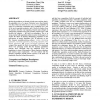Free Online Productivity Tools
i2Speak
i2Symbol
i2OCR
iTex2Img
iWeb2Print
iWeb2Shot
i2Type
iPdf2Split
iPdf2Merge
i2Bopomofo
i2Arabic
i2Style
i2Image
i2PDF
iLatex2Rtf
Sci2ools
SAC
2008
ACM
2008
ACM
Dynamic populations in genetic algorithms
Biological populations are dynamic in both space and time, that is, the population size of a species fluctuates across their habitats over time. There are rarely any static or fixed size populations in nature. In evolutionary computation (EC), population size is one of the most important parameters and it received attention from EC pioneers from the very beginning. Despite many attempts to optimize the population sizing, the prevailing scheme in EC is still possibly the simplest -- the fixed size population. This is in strong contrast with population entities in nature. In this paper, we explore the effects of dynamic (fluctuating) populations on the performance of genetic algorithms (GA). In particular, we test five dynamic population-sizing patterns: random fluctuating population, increasing population, decreasing population, bellshaped population, and inverse bell-shaped population and compare them against the fixed size population. Our experiment shows very promising results that ...
Applied Computing | Evolutionary Computation | Fixed Size Populations | Population Size | SAC 2008 |
| Added | 28 Dec 2010 |
| Updated | 28 Dec 2010 |
| Type | Journal |
| Year | 2008 |
| Where | SAC |
| Authors | Zhanshan (Sam) Ma, Axel W. Krings |
Comments (0)

